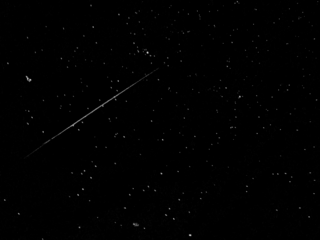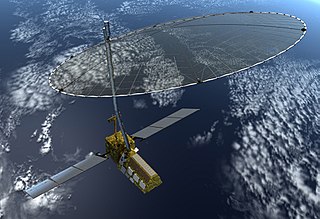Related Research Articles

RADARSAT-1 was Canada's first commercial Earth observation satellite. It utilized synthetic aperture radar (SAR) to obtain images of the Earth's surface to manage natural resources and monitor global climate change. As of March 2013, the satellite was declared non-operational and is no longer collecting data.
The Canadian Space Agency is the national space agency of Canada, established in 1990 by the Canadian Space Agency Act. The agency is responsible to the minister of innovation, science, and economic development.

Satellite images are images of Earth collected by imaging satellites operated by governments and businesses around the world. Satellite imaging companies sell images by licensing them to governments and businesses such as Apple Maps and Google Maps. It should not be confused for astronomy images collected by space telescope.
RADARSAT-2 is a Canadian Space Agency (CSA) Earth observation satellite. It launched on 14 December 2007 aboard a Starsem Soyuz-FG rocket from Baikonur Cosmodrome, Kazakhstan. The spacecraft is owned by MDA

Space-based radar is space-borne radar systems that may have any of a variety of purposes. A number of Earth-observing radar satellites, such as RADARSAT, have employed synthetic aperture radar (SAR) to obtain terrain and land-cover information about the Earth.

Seasat was the first Earth-orbiting satellite designed for remote sensing of the Earth's oceans and had on board one of the first spaceborne synthetic-aperture radar (SAR). The mission was designed to demonstrate the feasibility of global satellite monitoring of oceanographic phenomena and to help determine the requirements for an operational ocean remote sensing satellite system. Specific objectives were to collect data on sea-surface winds, sea-surface temperatures, wave heights, internal waves, atmospheric water, sea ice features and ocean topography. Seasat was managed by NASA's Jet Propulsion Laboratory and was launched on 27 June 1978 into a nearly circular 800 km (500 mi) orbit with an inclination of 108°. Seasat operated until 10 October 1978 (UTC), when a massive short circuit in the Agena-D bus electrical system ended the mission.
Surrey Satellite Technology Ltd, or SSTL, is a company involved in the manufacture and operation of small satellites. A spin-off company of the University of Surrey, it is presently wholly owned by Airbus Defence and Space.

RADARSAT is a Canadian remote sensing Earth observation satellite program overseen by the Canadian Space Agency (CSA). The program has consisted of:

Copernicus is the European Union's Earth observation programme coordinated and managed by the European Commission in partnership with the European Space Agency (ESA), the EU Member States and EU agencies.

COSMO-SkyMed is an Earth-observation satellite space-based radar system funded by the Italian Ministry of Research and Ministry of Defence and conducted by the Italian Space Agency (ASI), intended for both military and civilian use. The prime contractor for the spacecraft was Alenia Spazio. COSMO SkyMed is a constellation of four dual use ISR Earth observation satellites with a synthetic-aperture radar as main payload, the result of the intuition of Giorgio Perrotta in the early nineties. The synthetic aperture radar was developed starting in the late nineties with the SAR 2000 program funded by ASI.

SAOCOM is an Earth observation satellite constellation of Argentina's space agency CONAE. Two satellites are already orbiting the Earth in a Sun-synchronous orbit. The second one was launched on 30 August 2020.

Sentinel-1 is the first of the Copernicus Programme satellite constellation conducted by the European Space Agency. This mission is composed of a constellation of two satellites, Sentinel-1A and Sentinel-1B, which share the same orbital plane. They carry a C-band synthetic-aperture radar instrument which provides a collection of data in all-weather, day or night. This instrument has a spatial resolution of down to 5 m and a swath of up to 400 km. The constellation is on a sun synchronous, near-polar (98.18°) orbit. The orbit has a 12-day repeat cycle and completes 175 orbits per cycle.
Polar Epsilon is a Canadian Forces project to provide enhanced all-weather day and night surveillance capabilities utilizing imagery from the RADARSAT-2 earth observation satellite. The project includes two new ground stations, one at each coast. Data is primarily used to support military operations, but can also be accessed by other departments or agencies.
UrtheCast is a Vancouver-based Canadian earth observation company. It produced two cameras on the International Space Station. One of these is a medium resolution camera and the other is the first ultra-high definition video camera in space. The company went public on the Toronto Stock Exchange in June 2013 but was delisted in October 2020 after it filed for creditor protection.
Maritime domain awareness (MDA) is defined by the International Maritime Organization as the effective understanding of anything associated with the maritime domain that could impact the security, safety, economy, or environment. MDA is said to work as a ‘key enabler’ for other maritime security issues, such as anti-piracy patrols, in the way that in order to do effective patrols you need to have the ability of conducting effective MDA. The maritime domain is defined as all areas and things of, on, under, relating to, adjacent to, or bordering on a sea, ocean, or other navigable waterway, including all maritime-related activities, infrastructure, people, cargo, and vessels and other conveyances.

The NASA-ISRO Synthetic Aperture Radar (NISAR) mission is a joint project between NASA and ISRO to co-develop and launch a dual-frequency synthetic aperture radar on an Earth observation satellite. The satellite will be the first radar imaging satellite to use dual frequencies. It will be used for remote sensing, to observe and understand natural processes on Earth. For example, its left-facing instruments will study the Antarctic cryosphere. With a total cost estimated at US$1.5 billion, NISAR is likely to be the world's most expensive Earth-imaging satellite.
Heather McNairn, is a federal research scientist at the Ottawa Research and Development Centre, Agriculture and Agri-Food Canada. She specializes in remote sensing technology, and her research focuses on the use of Synthetic Aperture Radar satellites (SARs) to monitor the condition of crops and soils.

Paz is a Spanish Earth observation and reconnaissance satellite launched on 22 February 2018. It is Spain's first spy satellite. The satellite is operated by Hisdesat. Paz was previously referred to as SEOSAR.
RISAT-2B, or Radar Imaging Satellite-2B is an Indian radar reconnaissance satellite that is part of India's RISAT programme and the third satellite in the series. It is built by Indian Space Research Organisation (ISRO) to replace RISAT-2.

The International-Mars Ice Mapper (I-MIM) mission is a proposed Mars orbiter being developed by NASA in collaboration with the Japan Aerospace Exploration Agency (JAXA), the Canadian Space Agency (CSA), and the Italian Space Agency (ASI). As the mission concept evolves, there may be opportunities for other space agency and commercial partners to join the mission. The goal of the orbiter is the quantification of extent and volume of water ice in non-polar regions of Mars. The results are intended to support future Mars missions, especially with respect to the search for habitable environments and accessible In situ resource utilization (ISRU) resources. The International-Mars Ice Mapper is an "exploration precursor mission", comparing it to the Lunar Reconnaissance Orbiter (LRO) mission. The mission could launch as early as 2026.
References
- 1 2 3 4 5 Satellite characteristics. RADARSAT Mission. Canadian Space Agency.
- 1 2 Agency, Canadian Space (2019-06-12). "Canada's next-generation RADARSAT satellite constellation successfully launches to space". gcnws. Retrieved 2019-06-13.
- ↑ "Radar Satellite (RADARSAT)".
- ↑ "MDA Starts Work on Next Generation Satellite Constellation" . Retrieved 2006-09-03.
- ↑ "MDA Space Missions - What We Do - Satellite Missions - RADARSAT Constellation Mission". Archived from the original on 2007-02-22. Retrieved 2006-09-03.
- 1 2 3 4 "RADARSAT Constellation - eoPortal Directory - Satellite Missions". directory.eoportal.org. Retrieved 2019-03-11.
- ↑ "Canada To Build, Launch Three More Satellites" . Retrieved 2006-09-03.
- ↑ Pugliese, David. "Radarsat Constellation to track ships, provide surveillance over Arctic and other regions - satellites successfully launched". Ottawa Citizen. Retrieved 17 August 2020.
- ↑ "SpaceX Awarded Launch Reservation Contract for Largest Canadian Space Program" . Retrieved 30 July 2013.
- ↑ Ralph, Eric (2019-04-26). "SpaceX ships Falcon 9 booster west for second California launch of 2019". TESLARATI. Retrieved 2019-06-03.
- ↑ "Frequently Asked Questions - RADARSAT Constellation Mission (RCM)". www.asc-csa.gc.ca. 2018-07-06. Retrieved 2019-03-10.
- ↑ "COM DEV to Participate in Canada's New RADARSAT Constellation Mission" . Retrieved 2006-09-03.
- ↑ RADARSAT - Main applications. Canadian Space Agency.
- ↑ "RCM".
- ↑ RADARSAT - Components and specifications. Canadian Space Agency. Accessed on 16 January 2019.